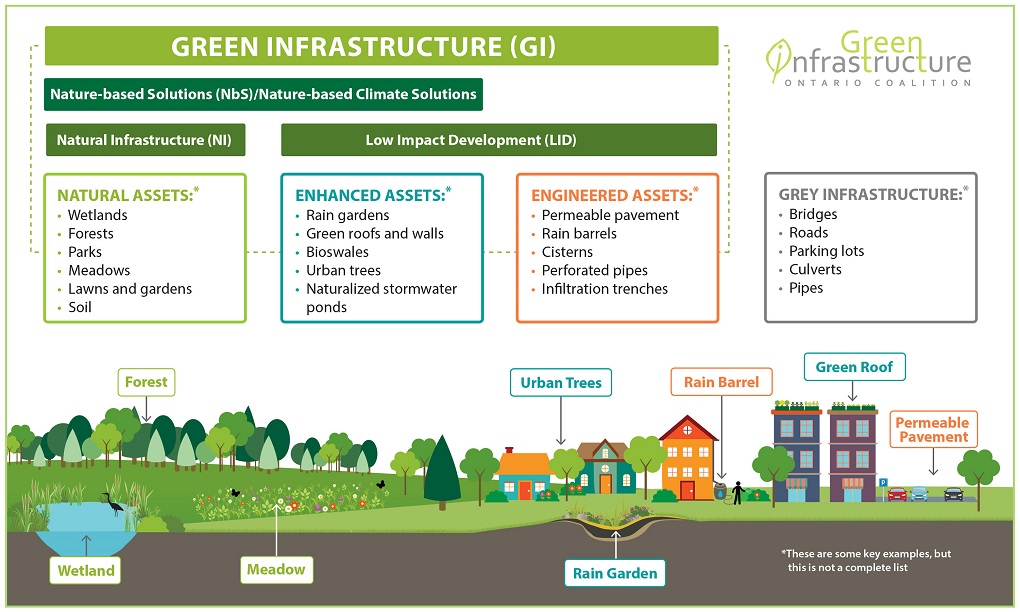How can cities across Canada advance equitable, abundant and thriving green infrastructure (GI)?
That’s the challenge that OLW member, Green Communities Canada (GCC), has been working to address with their Living Cities Canada: Green For All project. The project emerged from the collaborative work of the Green Infrastructure Community of Practice, an OLW Team, and is now supported by GCC, Green Infrastructure Ontario and researchers at the University of Toronto. It aims to advance equitable, abundant and thriving green infrastructure by:
- Building municipal capacity, support and action for GI;
- Growing public awareness, support, and action for GI.
The project is currently being piloted in five communities across Canada, and the team plans to scale up to include other communities in future years.
Side-Bar: What is GI and what does it have to do with “all waters in good health by 2030?”
To make sure we’re on the same page, here is a quick primer on GI and its benefits. GI refers to assets that use nature or natural processes to provide services like watershed management, recreation and more. Since naturally-occurring ecosystems like wetlands and forests also provide many services to people, they are included under the GI umbrella.

Unlike traditional “grey infrastructure” (roads, stormwater drains and pipes, treatment plants, etc.) that are built to offer a single service, GI offers a range of benefits and services to our (human and non-human) communities. This includes increasing our resilience to climate impacts, supporting urban biodiversity, improving residents’ health, and more.

It is also a critical piece of the puzzle in safeguarding water health. That’s why green infrastructure is one of Our Living Waters’ impact measures, contributing towards our ambitious goal of all waters in good health.
Co-Creating the (Permeable) Path Forward
The benefits of GI have been well documented for years. However, this knowledge has been slow to inform practice in the vast majority of municipalities, where grey infrastructure is still the default. When GI solutions are used, they are often piecemeal and disconnected from broader land-use strategies.
Living Cities Canada: Green For All envisions a Canada where green infrastructure is “the new normal”:
- with abundant GI in communities across the country;
- where GI is thriving, delivering the full range of benefits to people;
- where GI is equitable, being prioritized in neighbourhoods with the highest social and environmental needs.
At the end of March, the Living Cities Canada project team held a forum that brought together dozens of GI practitioners, advocates, researchers, consultants and community organizers from across Canada to discuss how we can work together to achieve these goals. Some themes that came up were:
- Equity and Environmental Justice. Low-income neighbourhoods and neighbourhoods with higher populations of black people, Indigenous peoples, and people of colour are much more likely to be “under-natured”. Important steps to address this issue include: mapping GI against socio-economic factors to identify priority areas for new projects; working with residents to co-design new GI projects; ensuring that GI projects do not result in “green gentrification.”
- Maintenance, Monitoring and Evaluation. Many municipalities do not adequately budget to properly maintain GI or monitor its performance. Partnerships with community groups and academics are potential solutions to ensure these tasks are done. Creating maintenance and evaluation plans that account for actions 5-10 years into the future is also an important strategy.
- Adequate Funding. A revenue stream to properly resource GI implementation is crucial, using, for example, municipal stormwater fees. Business models for GI should identify where and how to ask for “new money” and also strategically mobilize existing funds. This can be done by showcasing the value of natural assets through natural capital asset management.
- Involving the Community. Unlike grey infrastructure, GI is a decentralized strategy that is implemented broadly across the landscape. Community groups should be a big part of the transformation from “grey to green” for it to be successful, so building community trust is important. Community organizations can be good intermediaries between municipal governments and local residents in this regard.
- Training and Education. People need training and education to deliver various technical aspects of GI, whether at the operational level (e.g. maintenance) or at the policy and planning level. Investing in training and competencies for staff in GI-related fields will best set up municipalities and their partners for success.
- GI and Right Relations. GI centres humans and the services we derive from nature in a hierarchical and colonial frame of reference. This does not align with Indigenous peoples and perspectives and may alienate them from GI-related work. However, restoring urbanized land with native trees and plants can also be an important way to advance Right Relations, as we reconcile our relationship with the land as well as with Indigenous peoples. Addressing this tension and working with Indigenous peoples in appropriate and authentic ways is critical.
- Aligning Governance. GI requires a different strategy than traditional grey infrastructure; its planning and implementation requires collaboration between multiple different players. This means that it requires aligning communications and operations internally across departments in local governments, as well as making partnerships with other levels of government, governmental agencies, civil society and private sector actors.
See the full report and presentations from the virtual forum here.
The Living Cities Canada team is working to integrate the input from forum participants, as well as insights generated from extensive research, into its forthcoming A Framework For Living Cities — a document that will detail strategies, best practice, and considerations to advance equitable, abundant and thriving GI. Then, they will work with each of the five pilot communities to craft a community-specific pathway forward to become a Living City.